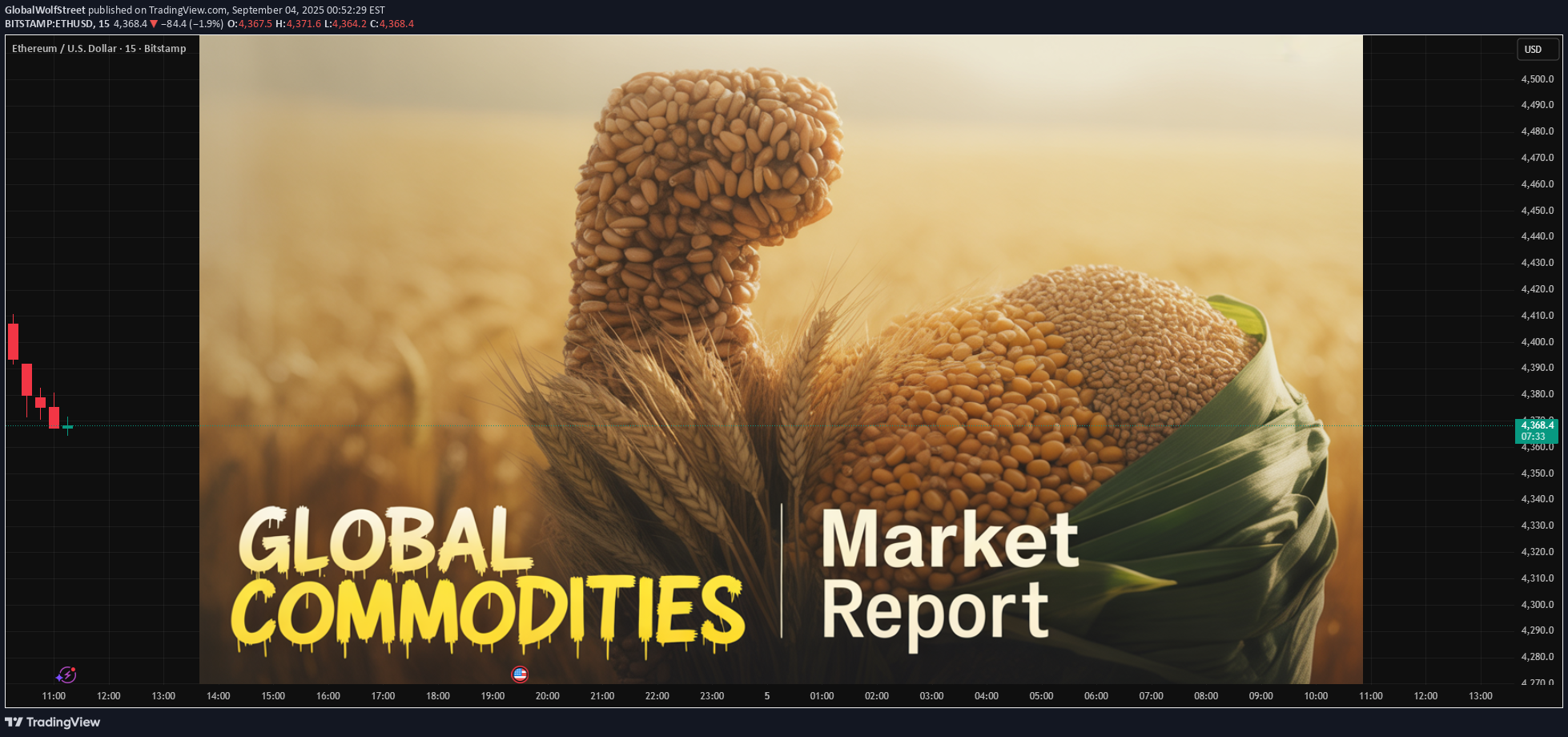تحلیل تکنیکال GlobalWolfStreet درباره نماد ETH در تاریخ ۱۴۰۴/۶/۱۳

What Are Agricultural Commodities? Agricultural commodities are raw, unprocessed products grown or raised to be sold or exchanged. They fall broadly into two categories: Food Commodities Grains & cereals: Wheat, rice, maize, barley, oats. Oilseeds: Soybeans, rapeseed, sunflower, groundnut. Fruits & vegetables: Bananas, citrus, potatoes, onions. Livestock & animal products: Beef, pork, poultry, dairy, eggs. Tropical commodities: Coffee, cocoa, tea, sugar. Non-Food Commodities Fibers: Cotton, jute, wool. Biofuel crops: Corn (ethanol), sugarcane (ethanol), palm oil, soy oil (biodiesel). Industrial crops: Rubber, tobacco. These commodities are traded on spot markets (immediate delivery) and futures markets (contracts for future delivery). Futures trading, which developed in places like Chicago and London, allows farmers and buyers to hedge against price fluctuations. Historical Context of Agricultural Commodities Trade Ancient Trade: The Silk Road and spice trade routes included agricultural goods like rice, spices, and tea. Grain storage and trade were central to the Roman Empire and ancient Egypt. Colonial Era: European colonial powers built empires around commodities like sugar, cotton, tobacco, and coffee. 20th Century: Mechanization, the Green Revolution, and globalization expanded agricultural production and trade. 21st Century: Digital platforms, biotechnology, and sustainability initiatives shape modern agricultural commodity markets. This long history shows how agriculture is not just economic, but political and cultural. Key Players in the Global Agricultural Commodities Market Producers (Farmers & Agribusinesses): Smallholder farmers in Asia and Africa; large-scale industrial farms in the U.S., Brazil, and Australia. Traders & Merchants: Multinational corporations known as the ABCD companies—Archer Daniels Midland (ADM), Bunge, Cargill, and Louis Dreyfus—dominate global grain and oilseed trade. Governments & Agencies: World Trade Organization (WTO), Food and Agriculture Organization (FAO), national agricultural boards. Financial Institutions & Exchanges: Chicago Board of Trade (CBOT), Intercontinental Exchange (ICE), and hedge funds/speculators who trade futures. Consumers & Industries: Food processing companies, retailers, biofuel producers, and ultimately, households. Major Agricultural Commodities and Their Markets 1. Cereals & Grains Wheat: Staple for bread and pasta, major producers include Russia, the U.S., Canada, and India. Rice: Lifeline for Asia; grown largely in China, India, Thailand, and Vietnam. Corn (Maize): Used for food, feed, and ethanol; U.S. and Brazil dominate exports. 2. Oilseeds & Oils Soybeans: Key protein for animal feed; U.S., Brazil, and Argentina lead. Palm Oil: Major in Indonesia and Malaysia; used in food and cosmetics. Sunflower & Rapeseed Oil: Important in Europe, Ukraine, and Russia. 3. Tropical Commodities Coffee: Produced mainly in Brazil, Vietnam, Colombia, and Ethiopia. Cocoa: Critical for chocolate; grown in West Africa (Ivory Coast, Ghana). Sugar: Brazil, India, and Thailand dominate. 4. Livestock & Dairy Beef & Pork: U.S., Brazil, China, and EU major players. Poultry: Fastest-growing meat sector, strong in U.S. and Southeast Asia. Dairy: New Zealand, EU, and India lead in milk and milk powder exports. 5. Fibers & Industrial Crops Cotton: Vital for textiles; India, U.S., and China are leading producers. Rubber: Largely grown in Southeast Asia for tires and industrial use. Factors Influencing Agricultural Commodity Markets Weather & Climate: Droughts, floods, hurricanes, and heatwaves strongly affect supply. Technology: Mechanization, biotechnology (GM crops), digital farming, and precision agriculture boost productivity. Geopolitics: Wars, sanctions, and trade disputes disrupt supply chains (e.g., Russia-Ukraine war and wheat exports). Currency Fluctuations: Commodities are priced in USD; exchange rates impact competitiveness. Government Policies: Subsidies, tariffs, price supports, and export bans affect markets. Consumer Demand: Rising demand for protein, organic food, and biofuels shapes production. Speculation: Futures and derivatives markets amplify price volatility. Supply Chain of Agricultural Commodities Production (Farmers). Collection (Local traders & cooperatives). Processing (Milling, crushing, refining). Storage & Transportation (Warehouses, silos, shipping lines). Trading & Export (Grain merchants, commodity exchanges). Retail & Consumption (Supermarkets, restaurants, households). The supply chain is global—soybeans grown in Brazil may feed livestock in China, which supplies meat to Europe. Global Trade in Agricultural Commodities Top Exporters: U.S., Brazil, Argentina, Canada, EU, Australia. Top Importers: China, India, Japan, Middle East, North Africa. Trade Routes: Panama Canal, Suez Canal, Black Sea, and major ports like Rotterdam, Shanghai, and New Orleans. Agricultural trade is often uneven—developed nations dominate exports, while developing nations rely heavily on imports. Price Volatility in Agricultural Commodities Agricultural commodities are highly volatile due to: Seasonal cycles of planting and harvest. Weather shocks (El Niño, La Niña). Energy prices (fertilizers, transport). Speculative trading on futures markets. Volatility impacts both farmers’ incomes and consumers’ food security. Role of Futures and Derivatives Markets Commodity exchanges such as CBOT (Chicago), ICE (New York), and NCDEX (India) allow: Hedging: Farmers and buyers reduce risk by locking in prices. Speculation: Traders bet on price movements, adding liquidity but also volatility. Price Discovery: Futures prices signal supply-demand trends. Challenges Facing the Global Agricultural Commodities Market Climate Change: Increased droughts, floods, and pests reduce yields. Food Security: Rising global population (10 billion by 2050) requires 50% more food production. Trade Wars & Protectionism: Export bans (e.g., rice from India, wheat from Russia) destabilize markets. Sustainability: Deforestation for soy and palm oil, pesticide use, and water scarcity are major concerns. Market Power Concentration: Few large corporations dominate, raising fairness concerns. Infrastructure Gaps: Poor roads, ports, and storage in developing nations lead to waste. Future Trends in Agricultural Commodities Market Sustainability & ESG: Demand for eco-friendly, deforestation-free, and fair-trade commodities. Digitalization: Blockchain for traceability, AI for crop forecasting, precision farming. Biofuels & Renewable Energy: Growing role of corn, sugarcane, and soy in energy transition. Alternative Proteins: Lab-grown meat, plant-based proteins reducing demand for livestock feed. Regional Shifts: Africa emerging as a key producer and consumer market. Climate-Resilient Crops: GM crops resistant to drought, pests, and diseases. Case Studies Russia-Ukraine War (2022–2025): Disrupted global wheat, corn, and sunflower oil supply, driving food inflation. COVID-19 Pandemic (2020): Supply chain breakdowns exposed vulnerabilities in agricultural trade. Palm Oil in Indonesia: Tensions between economic growth and environmental concerns over deforestation. Conclusion The global agricultural commodities market is one of the most important pillars of the world economy. It determines food security, influences geopolitics, and drives livelihoods for billions of farmers. However, it is also one of the most vulnerable markets—shaped by climate change, population growth, technological advances, and political instability. In the future, balancing food security, sustainability, and fair trade will be the central challenge. With the right policies, innovation, and cooperation, agricultural commodity markets can continue to feed the world while protecting the planet.
